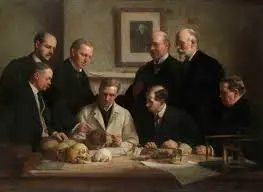The Evolution Revolution: The Same Old Thing
by Kyle Butt, M.A.
For the past century, scientists who adhere to Darwinism have been parading before the public amazing “evidence” that allegedly proves the triumph of organic evolution over biblical creation. These enlightened scholars have ridiculed the poor, ignorant, outmoded creationists for not being up-to-date with the latest, cutting-edge scientific breakthroughs. Such ridicule has been especially evident in the field of alleged human evolution. Evolutionists mock the creationists for their failure to accept the “factual” evidence that proves humans evolved from ape-like ancestors. But the evolutionists’ evidence often proves to be an ever-shifting quagmire fraught with error—and sometimes even fraud.
A classic example of this can be seen in the Scopes Monkey trial held in Dayton, Tennessee in 1925. During that trial, eight “expert” witnesses were available to testify in favor of the legitimacy of evolutionary theory. Only one of them actually testified on the stand, but the others submitted affidavits documenting evidence which they claimed supported evolution. Four of the experts were Fay Cooper Cole (Professor of Anthropology at the University of Chicago), Kirtley F. Mather (Chairman of the Geology department at Harvard University), Wilbur A. Nelson (State Geologist for Tennessee), and Horatio Hackett Newman (Dean of the College of Science at the University of Chicago). The combined testimony of these four men suggested that fossils from Piltdown Man and Java Man (classified as Homo erectus), as well as other “ancestors” composed a clear evolutionary history of humans from ape-like ancestors (Bradbury, n.d.). Yet, in the early 1950s, scientists discovered that Piltdown Man was a hoax (see Harrub and Thompson, 2003, p. 90), and the recent issue of Newsweek stated: “DNA makes clear that Homo erectus was almost certainly a dead end and not, as some scientists had argued, our ancestor” (Begley, 2007, 149[12]:55). Summarizing the situation, then, the “experts” in the field of alleged human evolution in 1925 presented the best evidence they had at the time, which turned out to be wrong.
Enter Sharon Begley’s latest article, featured on the cover of the March 19, 2007 issue of Newsweek. The cover reads: “The Evolution Revolution: The New Science of the Brain and DNA is Rewriting the Story of Human Origins.” The main thesis of the inside article seems to be that traditional views of human evolution, long held by many in the scientific community, simply are not accurate. Begley says that recent discoveries are “overturning longstanding ideas about how we became human” (2007, 149[12]:54). One caption placed beside a 1935 museum picture states: “As fossil finds and DNA analysis have expanded our knowledge of our species’ family tree, the old linear evolutionary model of monkey to man has been supplanted by one vastly more complex” (2007, 149[12]:56).
Before proceeding any further, one main point should not be missed. Begley basically is saying that all the scientific experts in the past who presented “the old linear model” of human evolution have been wrong. Think about that. What did the evolutionary scientists in the past use to “prove” that humans evolved from ape-like ancestors? Answer: the “old linear model” of human evolution. But that has now been debunked. So experts like those present at the Scopes trial used false information, presented it as cutting-edge “proof” of evolution, and now that information maintains zero value for proving human evolution. Does Begley expect us to believe that the “modern” research is going to fare any better 50 years from now? Why can’t the evolutionary community see that with every admission that old evidence is supplanted, it becomes clear that the “evidence” never really proved anything in the first place? How many times will the tree of human evolution need to be pruned, cut down, and replanted before the majority of intelligent readers realize that it is not the evidence that is driving scientists to believe that humans evolved from animals; it is the dogmatically held theory of evolution that is driving scientists to produce “evidence” to support it?
MOLECULAR CLOCKS
Throughout her article, Begley repeatedly appeals to the idea of “molecular clocks.” She suggests that by comparing DNA from different organisms, scientists can calculate when these organisms evolved into different organism. In the introduction to her article, she explains that this process is like “calculating how long it took a typist to produce a document if you know he makes six typos per minute” (2007, 149[12]:53). In her discussion of the difference between human DNA and chimpanzee DNA, she stated that “DNA changes at a fairly regular rate. That lets scientists use this rate to calibrate a ‘molecular clock’ whose tick-tocks measure how long ago a genetic change occurred” (2007, 149[12]:54). Begley uses this “molecular clock” idea so often that it seems to be one (if not the) main line of evidence to support her thesis. She uses the “molecular clock” idea again when discussing a gene named HAR1 (p. 55), when describing a gene called PDYN (p. 56), and in her discussion of genes FOXP2 and ASPM (p. 58).
The main problem with the molecular clock idea is that it is based on faulty assumptions and has been shown to be devastatingly inaccurate. Thompson and Harrub soundly refuted the “molecular clock” idea in their two-part series titled “The Molecular Evidence of Human Origins” (2005). In that refutation, several quotes from those in the scientific community show the problems with molecular dating. For instance, Francisco Rodriguez-Trelles and his fellow researchers observed:
The neutrality theory predicts that the rate of neutral molecular evolution is constant over time, and thus that there is a molecular clock for timing evolutionary events. It has been observed that the variance of the rate of evolution is generally larger than expected according to the neutrality theory, which has raised the question of how reliable the molecular clock is or, indeed, whether there is a molecular clock at all…. The observations are inconsistent with the predictions made by various subsidiary hypotheses proposed to account for the overdispersion of the molecular clock (Rodriguez-Trelles, et al., 2001, 98:11405, emp. added).
The next year, in 2002, Rodriguez-Trelles and his colleagues published another report in which they stated:
Despite the booming amount of sequence information, molecular timing of evolutionary events has continued to yield conspicuously deeper dates than indicated by the stratigraphic data. Increasingly, the discrepancies between molecular and paleontological estimates are ascribed to deficiencies of the fossil record, while sequence-based time tables gain credit. Yet, we have identified a fundamental flaw of molecular dating methods, which leads to dates that are systematically biased towards substantial overestimation of evolutionary times (Rodriguez-Trelles, et al., 2002, 98:8114, emp. added).
Begley’s heavy reliance on such questionable methods casts serious doubt on the legitimacy of her conclusions. Furthermore, the “molecular clock” idea is based on the assumption that it is even possible to mutate an organism’s DNA in such a way as to change the organism into another kind of life form. This assumption flies in the face of everything we know experimental about biology and the law of biogenesis (see Thompson, 1989).
CONCLUSION
Begley’s article is far from revolutionary. It rehashes many of the same arguments for human evolution that previously have been effectively refuted. Her suggestion that the “old linear” idea of human evolution is giving way to a newly-formed idea of human evolution is a glaring admission that what has been called “science” in the field of human evolution has proven to be little more that specious propaganda designed to uphold the theory of evolution in spite of its lack of evidence. Her reliance on the “molecular clock,” in spite of its evident shortcomings, points to the fact that the case for human evolution continues to weaken, notwithstanding the scientific community’s claims to the contrary. Begley has produced nothing in her article that would constrain a person to believe that humans evolved from lower mammals, especially in light of the fact that everything Begley has presented will most likely be debunked by the “experts” 50 years from now, should the world last. It is refreshing to know that no matter what new “evidence” the evolutionary scientific community has concocted to “prove” human evolution 50 years from now, the biblical text will still provide the truth: “So God created man in His own image; in the image of God He created him; male and female He created them” (Genesis 1:27).
REFERENCES
Begley, Sharon (2007), “Beyond Stones and Bones,” Newsweek, 149[12]:53-58, March 19.
Bradbury, Andy (no date), “The Scopes Monkey Trial,” [On-line], URL: http://www.bradburyac.mistral.co.uk/tenness5.html.
Harrub, Brad and Bert Thompson (2003), The Truth About Human Origins (Montgomery, AL: Apologetics Press).
Rodriguez-Trelles, Francisco, Rosa Tarrio, and Francisco J. Ayala (2001), “Erratic Overdispersion of Three Molecular Clocks: GPDH, SOD, and XDH,” Proceedings of the National Academy of Sciences, 98:11405-11410, September 25.
Rodriguez-Trelles, Francisco, Rosa Tarrio, and Francisco J. Ayala (2002), “A Methodological Bias Toward Overestimation of Molecular Evolutionary Time Scales,” Proceedings of the National Academy of Sciences, 99:8112-8115, June 11.
Thompson, Bert (1989), “The Bible and the Laws of Science: The Law of Biogenesis,” Reason & Revelation, [On-line], URL: http://www.apologeticspress.org/articles/330.
Thompson, Bert and Brad Harrub (2005), “Molecular Evidence of Human Origins: Parts 1 and 2,” Reason & Revelation, [On-line], URL: http://www.apologeticspress.org/articles/2718 and http://www.apologeticspress.org/articles/2734.







